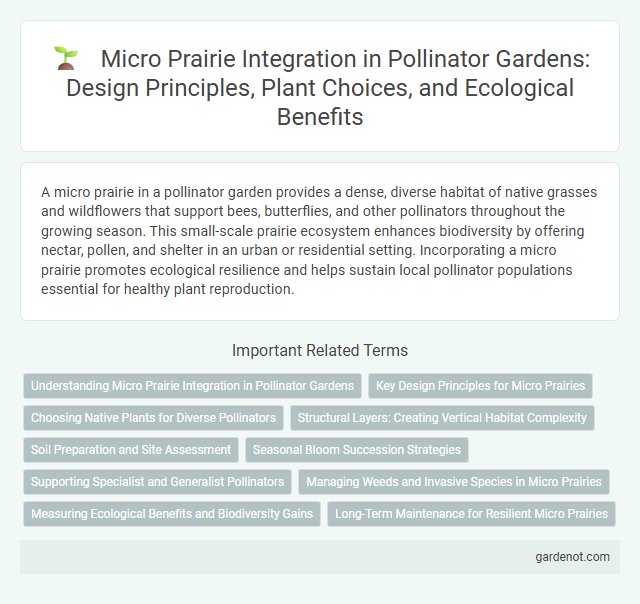A micro prairie in a pollinator garden provides a dense, diverse habitat of native grasses and wildflowers that support bees, butterflies, and other pollinators throughout the growing season. This small-scale prairie ecosystem enhances biodiversity by offering nectar, pollen, and shelter in an urban or residential setting. Incorporating a micro prairie promotes ecological resilience and helps sustain local pollinator populations essential for healthy plant reproduction.
Understanding Micro Prairie Integration in Pollinator Gardens
Micro prairies consist of dense, low-growing native grasses and wildflowers that provide continuous flowering resources, essential for sustaining diverse pollinator populations in gardens. Their integration enhances habitat complexity, offering nesting sites and abundant nectar sources for bees, butterflies, and other pollinators throughout multiple seasons. Establishing micro prairies in pollinator gardens supports biodiversity by mimicking natural prairie ecosystems on a smaller scale, promoting ecological resilience and pollination services.
Key Design Principles for Micro Prairies
Micro prairie design emphasizes native plant diversity, incorporating a mix of grasses and wildflowers to support pollinator habitats and enhance ecosystem resilience. Plant selection prioritizes species that bloom sequentially throughout growing seasons, ensuring continuous nectar and pollen availability for bees, butterflies, and other pollinators. Optimal soil preparation and maintenance practices promote healthy root development and minimize invasive species, fostering long-term sustainability and biodiversity in micro prairie gardens.
Choosing Native Plants for Diverse Pollinators
Choosing native plants for a micro prairie enhances habitat diversity, supporting a wide range of pollinators such as bees, butterflies, and hummingbirds. Native species like purple coneflower, black-eyed Susan, and milkweed provide essential nectar and pollen resources while adapting well to local soil and climate conditions. This approach promotes ecological balance, increasing pollinator abundance and overall garden resilience.
Structural Layers: Creating Vertical Habitat Complexity
Micro prairies enhance pollinator gardens by incorporating multiple structural layers, including low-growing groundcovers, mid-height flowering plants, and taller grasses, which mimic natural vertical habitat complexity. This stratification provides essential resources such as nectar, pollen, and shelter for diverse pollinator species throughout their life cycles. Creating vertical habitat complexity supports higher biodiversity and improves ecosystem resilience within urban and suburban landscapes.
Soil Preparation and Site Assessment
Soil preparation for a micro prairie involves testing pH levels and nutrient content to ensure optimal conditions for native pollinator plants. Site assessment includes evaluating sunlight exposure, soil texture, and drainage to select appropriate seed mixes that support local pollinator species. Proper preparation enhances root establishment and promotes a thriving, biodiverse pollinator garden ecosystem.
Seasonal Bloom Succession Strategies
Micro prairies utilize seasonal bloom succession strategies by incorporating a diverse mix of native flowering plants that bloom at varying times throughout the growing season, ensuring continuous forage for pollinators. Early spring blossoms like native phlox and wild geraniums support emerging pollinators, while summer blooms such as coneflowers and butterfly milkweed provide critical nectar sources. Late-season flowers including goldenrod and asters extend forage availability into fall, sustaining pollinator populations before winter dormancy.
Supporting Specialist and Generalist Pollinators
Micro prairies provide essential habitats by incorporating diverse native plants that attract specialist pollinators such as bees and butterflies while also supporting generalist pollinators like flies and beetles. The dense plant variety ensures continuous bloom periods, offering consistent nectar and pollen sources critical for pollinator health and biodiversity. This habitat complexity enhances pollination efficiency, contributing significantly to ecosystem stability and crop productivity.
Managing Weeds and Invasive Species in Micro Prairies
Effective management of weeds and invasive species in micro prairies is crucial for maintaining biodiversity and promoting native pollinator habitats. Techniques such as regular hand weeding, targeted mowing, and selective herbicide application help control unwanted plants without disrupting beneficial flora. Monitoring invasive species early and implementing integrated pest management strategies prevent dominance of aggressive plants that can degrade pollinator resources.
Measuring Ecological Benefits and Biodiversity Gains
Micro prairies in pollinator gardens significantly enhance biodiversity by providing diverse native plant species that support various pollinators such as bees, butterflies, and hummingbirds. Measuring ecological benefits involves monitoring pollinator visitation rates, species richness, and habitat quality improvements over time. Quantitative data from these assessments demonstrate increased pollinator populations and improved ecosystem resilience in urban and suburban environments.
Long-Term Maintenance for Resilient Micro Prairies
Long-term maintenance of micro prairies in pollinator gardens involves strategic mowing schedules, targeted invasive species control, and periodic soil health assessments to sustain native plant diversity and enhance habitat resilience. Employing adaptive management practices, such as selective thinning and seasonal burns, supports the ecological balance necessary for pollinator populations. Monitoring efforts and data-driven interventions optimize micro prairie vitality, ensuring sustained ecosystem services over time.
Micro prairie Infographic

 gardenot.com
gardenot.com